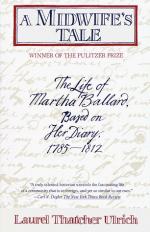|
This section contains 561 words (approx. 2 pages at 400 words per page) |

|
A Midwife's Tale: The Life of Martha Ballard, Based on Her Diary, 1785-1812 Summary & Study Guide Description
A Midwife's Tale: The Life of Martha Ballard, Based on Her Diary, 1785-1812 Summary & Study Guide includes comprehensive information and analysis to help you understand the book. This study guide contains the following sections:
This detailed literature summary also contains Topics for Discussion on A Midwife's Tale: The Life of Martha Ballard, Based on Her Diary, 1785-1812 by Laurel Thatcher Ulrich.
The book is an incredible history of the life of the average midwife of late 18th Century New England. This is an area of information that has been overlooked and understudied for many years. The book starts out with a history of Martha Ballard up until the time she and her husband, Ephraim, move to Hallowell. The diary begins in Hallowell and explains the remainder of Martha's life through her midwife practice; her garden; travels taken by herself, family, and neighbors; trading; weaving, and trials.
Each chapter is representative of just one aspect of the life of a woman in the late 18th Century. It explains how the women of the community worked to help provide for their families. Martha had two businesses: weaving and midwifery.
The next section delves into the community of Hallowell. It explains the differences between the male populace and the female populace and the few times where the two groups mix.
After the explanation of the social differences, religion and courts become the topics. It gives an idea as to how the women of the late 18th Century dealt with crimes against them, and how the outcome was influenced by the men in the community.Then, Martha's diary explains courtship, or lack thereof, marriage, and premarital sex. Martha's entries show the acceptance and tolerance of the community, as well as the normal wedding process.
The book then explores Martha's midwife practice through the entries regarding the births she attended. It makes it clear that some things were not discussed with anyone other than the mother and the attendants. Martha begins to change and her diary becomes a release of emotions as well as a way for her to keep track of her accounts. Martha is aging and does not like it.
Martha's diary takes a turn. Although she is still regarded in a medical capacity in the community of Hallowell, the medical profession is growing and so are the intimidations of physicians in the area. Martha intimidates them by her traditional knowledge. It also shows, though the majority of physicians in the area defer certain patients to her, the younger women in the field are being pushed out of the field or have to become nurses.
Martha is feeling her age and begins to loose the independence that she has loved for most of her life. Ephraim is in jail, and she is depressed. Martha's son, his wife, and their family move in with Martha, which only makes her situation worse.
The murder/suicide of the Purrinton's, followed by two more suicides in Martha's neighborhood, are devastating. The community has a new way of looking at circumstances, and one another, after these occurrences. It shows how the community works together to help each other, especially in troubling times.
The Malta war of 1809 was fought over land. Martha did not show any real sign of interest. Martha had her garden and her midwife practice. However, in May of 1812, Martha died. Martha attended deliveries up until about a month before her death. Martha was an incredible woman, and her diary shows how hard her life was, and yet, she persisted and survived the best she could.
The epilogue tells the history of Martha's diary after her death. It was handed down through the family and eventually made its way to the Maine State Library.
Read more from the Study Guide
|
This section contains 561 words (approx. 2 pages at 400 words per page) |

|



